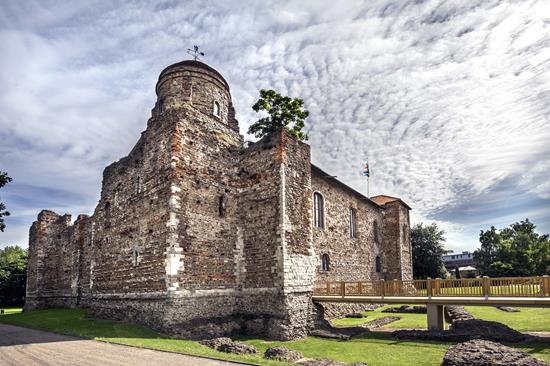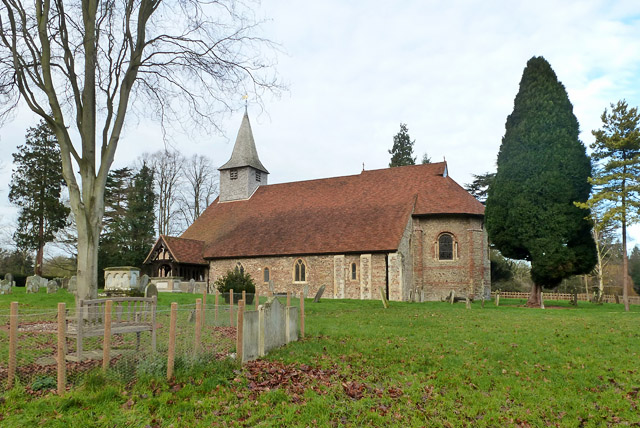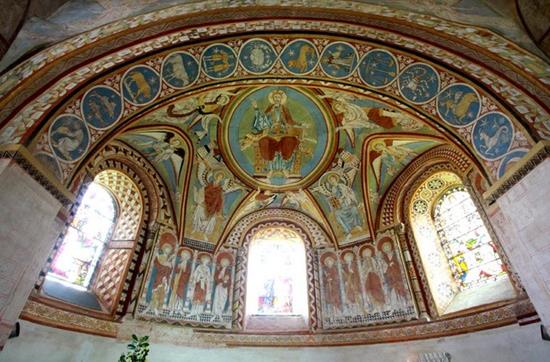The buildings of St John's Abbey were laid out in 1095 by Eudo Dapifer and the first of them completed in 1115. The cloister and domestic buildings lay north of the church, as a small hill occupied the land to the south. The abbey was burnt down in 1133 and all the workshops, which were originally on the north side were rebuilt to the south side of the church. The church was re-built on a cruciform plan, with a massive central tower and an elaborate west front flanked by south-west and north-west towers, possibly round. Late 12th century capitals, perhaps from the internal jambs of a window or from blind arcading, found near the abbey site, may have been from its church or chapter house. The abbey was dissolved in 1538.
 This Norman keep known as Colchester Castle was built around AD 1078 on the foundations of the Roman Temple of Claudius. It was built in at least two main phases and its initial form consisted of a single-storey stone keep with crenellated parapet wall. During the early 12th century, the keep's outer walls were raised by at least one storey and a fore-building was added on the south side to protect the main entrance. A barbican replaced this in the 13th century. The castle's earthwork defences consisted of an upper and 'nether' or lower bailey bank and ditch (to the north, and down-slope to the town wall) with at least one entrance in the upper bailey's south-west corner. The upper bailey defences had been built by 1101. The northern and eastern arms of the upper bailey defences survive as landscaped earthworks within Castle Park. The southern arms lies just to the north of the High Street, and the western arm, below or just to the east of Maidenburgh Street. The nether bailey is possibly part of a second phase, of the late 12th century. The southern end of the eastern arm of the nether bailey survives as a landscaped ditch in Castle Park. The western arm lies below or just to the east of Maidenburgh Street. A masonry chapel and domestic buildings stood to the south of the keep. The keep was partially demolished in the 17th century.
This Norman keep known as Colchester Castle was built around AD 1078 on the foundations of the Roman Temple of Claudius. It was built in at least two main phases and its initial form consisted of a single-storey stone keep with crenellated parapet wall. During the early 12th century, the keep's outer walls were raised by at least one storey and a fore-building was added on the south side to protect the main entrance. A barbican replaced this in the 13th century. The castle's earthwork defences consisted of an upper and 'nether' or lower bailey bank and ditch (to the north, and down-slope to the town wall) with at least one entrance in the upper bailey's south-west corner. The upper bailey defences had been built by 1101. The northern and eastern arms of the upper bailey defences survive as landscaped earthworks within Castle Park. The southern arms lies just to the north of the High Street, and the western arm, below or just to the east of Maidenburgh Street. The nether bailey is possibly part of a second phase, of the late 12th century. The southern end of the eastern arm of the nether bailey survives as a landscaped ditch in Castle Park. The western arm lies below or just to the east of Maidenburgh Street. A masonry chapel and domestic buildings stood to the south of the keep. The keep was partially demolished in the 17th century.
Colchester Castle is now home to Colchester Castle Museum where visitors can explore the Roman vaults and visit the roof of the castle for panoramic views around the town. The museum's collections focus on the history of Colchester and include many very significant finds such as the Kelvedon Warrior and the 'Fenwick hoard', a collection of Roman jewellery found under the Fenwick store on High Street, Colchester.
 The remains of a Roman circus , an arena for chariot racing, were discovered in 2004, during investigations in advance of the redevelopment of Colchester Garrison, approximately 450m south of the walled town.
The remains of a Roman circus , an arena for chariot racing, were discovered in 2004, during investigations in advance of the redevelopment of Colchester Garrison, approximately 450m south of the walled town.
Chariot racing was the oldest and most popular sport in the Roman world and the Colchester circus is the only example in the country. It is one of only six locations in the northwest provinces of the Roman Empire where circuses have been securely identified.
The Colchester Roman Circus is a classic example of its type - an elongated arena, approximately 450 metres long and 74 metres wide, comprising of a racing track flanked by tiered seating, known as a 'cavea', along the north and south long sides and around the curved (east) end. This would have provided perhaps as many as six tiers of seating around outside of the track, providing an estimated seating capacity for 8,000 people.
At one end of the track there was a row of eight starting gates and at the other a sharp 180 degree turn. The two long straight sections were separated by a barrier called a ‘spina’, which supported a series of decorative columns and other features, including lap counters and pressurised water features.
It was constructed around AD 125, probably on the orders of the emperor, Hadrian, who was in Britain at that time. The circus had already gone out of use by the end of the Roman period.
The building, i.e. the above-ground structure, is poorly preserved and there are no upstanding original walls or earthworks (which is the reason why the Circus was previously unknown). Today the Roman Circus Centre provides information about the site and visitors can see reconstructions of the starting gates and the seating.
 Founded between 1093 and 1100, the priory of St Botolph was one of the first religious houses in England to adopt Augustinian rule. It is located on the south-facing slope of a small valley outside Colchester's south-east gateway. It was preceded by an earlier church, which was served by a community of secular canons. The priory church, built in the 12th century (and dedicated in 1177), survives above ground, and there are also below-ground remains of cloistral buildings. The west front contains the traces of the earliest major round window in England, dating from around 1150. The extent of the precinct has not been accurately established.
Founded between 1093 and 1100, the priory of St Botolph was one of the first religious houses in England to adopt Augustinian rule. It is located on the south-facing slope of a small valley outside Colchester's south-east gateway. It was preceded by an earlier church, which was served by a community of secular canons. The priory church, built in the 12th century (and dedicated in 1177), survives above ground, and there are also below-ground remains of cloistral buildings. The west front contains the traces of the earliest major round window in England, dating from around 1150. The extent of the precinct has not been accurately established.
The site is open to the public, and managed by Colchester Borough Council. More information about visiting St Botolph's Priory is available from the English Heritage website.
 Described by Pevsner as 'the most remarkable Norman church in the county', the church of St Michael and All Angels is home to some of the best-preserved Norman wall paintings in Britain.
Described by Pevsner as 'the most remarkable Norman church in the county', the church of St Michael and All Angels is home to some of the best-preserved Norman wall paintings in Britain.
The church was built around 1125-1130, probably as a chapel by the Bishops of London. The whole church was originally vaulted, and the apse still is - Norman vaults in parish churches are extremely rare in England.
The 'Danes skin' from the north door has recently been re-examined and confirmed as human.
 In the apse of the church are mid-12th century wall paintings, much restored, depicting St Michael and St Gabriel and 10 apostles. At the centre is a majesty with rainbow supported by angels. The nave and chancel have numerous figures with extensive decorative work and diaper motifs.
In the apse of the church are mid-12th century wall paintings, much restored, depicting St Michael and St Gabriel and 10 apostles. At the centre is a majesty with rainbow supported by angels. The nave and chancel have numerous figures with extensive decorative work and diaper motifs.
The paintings are by far the most important medieval wall paintings in Essex. They date from the same time as the church, and are comparable with contemporary paintings in St Gabriel's Chapel, Canterbury Cathedral. They have been heavily restored, particularly those in the apse (pictured) which were discovered during restoration work in 1871-2 and over-painted.
This beautiful church is just 5 minutes off the A12 to the south of Colchester, and is open to the public. To find out more about visiting, please check the church website.
 This Norman keep known as
This Norman keep known as  The remains of a
The remains of a 

 In the apse of the church are mid-12th century wall paintings, much restored, depicting St Michael and St Gabriel and 10 apostles. At the centre is a majesty with rainbow supported by angels. The nave and chancel have numerous figures with extensive decorative work and diaper motifs.
In the apse of the church are mid-12th century wall paintings, much restored, depicting St Michael and St Gabriel and 10 apostles. At the centre is a majesty with rainbow supported by angels. The nave and chancel have numerous figures with extensive decorative work and diaper motifs.